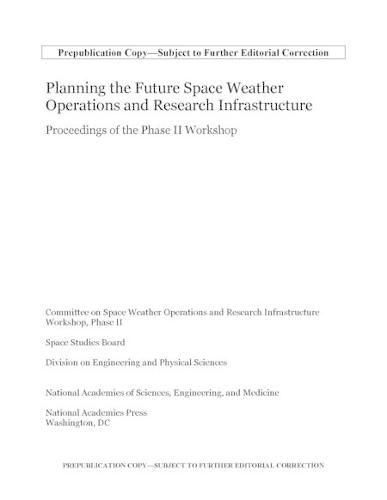Readings Newsletter
Become a Readings Member to make your shopping experience even easier.
Sign in or sign up for free!
You’re not far away from qualifying for FREE standard shipping within Australia
You’ve qualified for FREE standard shipping within Australia
The cart is loading…






Affecting technological systems at a global-scale, space weather can disrupt high-frequency radio signals, satellite-based communications, navigational satellite positioning and timing signals, spacecraft operations, and electric power delivery with cascading socioeconomic effects resulting from these disruptions. Space weather can also present an increased health risk for astronauts, as well as aviation flight crews and passengers on transpolar flights.
In 2019, the National Academies was approached by the National Aeronautics and Space Administration, the National Oceanic and Atmospheric Administration, and the National Science Foundation to organize a workshop that would examine the operational and research infrastructure that supports the space weather enterprise, including an analysis of existing and potential future measurement gaps and opportunities for future enhancements. This request was subsequently modified to include two workshops, the first ("Phase I") of which occurred in two parts on June 16-17 and September 9-11, 2020.
The Phase II workshop occurred on April 11-14, 2022, with sessions on agency updates, research needs, data science, observational and modeling needs, and emerging architectures relevant to the space weather research community and with ties to operational needs. This publication summarizes the presentation and discussion of that workshop.
Table of Contents
Front Matter Summary 1 The Space Weather Community 2 Research, Observation, and Modeling Needs: The Sun and Heliosphere 3 Research, Observation, and Modeling Needs: Magnetosphere, Ionosphere, Thermosphere, and Mesosphere 4 Research, Observation, and Modeling Needs: Ground Effects 5 Modeling, Validation, and Data Science 6 Research Infrastructure Appendixes Appendix A: Statement of Task Appendix B: Workshop Agenda Appendix C: Poster Session at the April 1114, 2022, Workshop Appendix D: Acronyms and Abbreviations Appendix E: Biographies of Committee Members and Staff
$9.00 standard shipping within Australia
FREE standard shipping within Australia for orders over $100.00
Express & International shipping calculated at checkout
Affecting technological systems at a global-scale, space weather can disrupt high-frequency radio signals, satellite-based communications, navigational satellite positioning and timing signals, spacecraft operations, and electric power delivery with cascading socioeconomic effects resulting from these disruptions. Space weather can also present an increased health risk for astronauts, as well as aviation flight crews and passengers on transpolar flights.
In 2019, the National Academies was approached by the National Aeronautics and Space Administration, the National Oceanic and Atmospheric Administration, and the National Science Foundation to organize a workshop that would examine the operational and research infrastructure that supports the space weather enterprise, including an analysis of existing and potential future measurement gaps and opportunities for future enhancements. This request was subsequently modified to include two workshops, the first ("Phase I") of which occurred in two parts on June 16-17 and September 9-11, 2020.
The Phase II workshop occurred on April 11-14, 2022, with sessions on agency updates, research needs, data science, observational and modeling needs, and emerging architectures relevant to the space weather research community and with ties to operational needs. This publication summarizes the presentation and discussion of that workshop.
Table of Contents
Front Matter Summary 1 The Space Weather Community 2 Research, Observation, and Modeling Needs: The Sun and Heliosphere 3 Research, Observation, and Modeling Needs: Magnetosphere, Ionosphere, Thermosphere, and Mesosphere 4 Research, Observation, and Modeling Needs: Ground Effects 5 Modeling, Validation, and Data Science 6 Research Infrastructure Appendixes Appendix A: Statement of Task Appendix B: Workshop Agenda Appendix C: Poster Session at the April 1114, 2022, Workshop Appendix D: Acronyms and Abbreviations Appendix E: Biographies of Committee Members and Staff